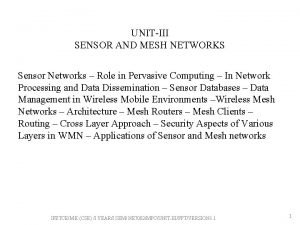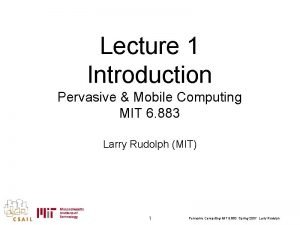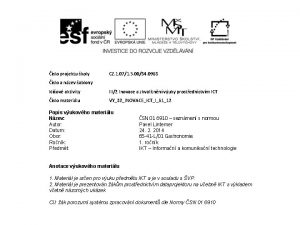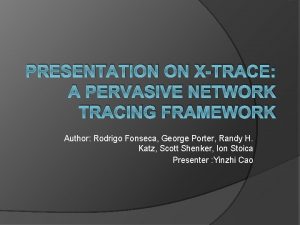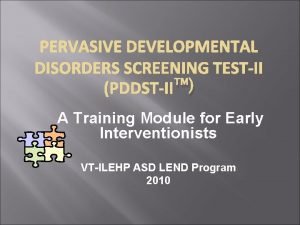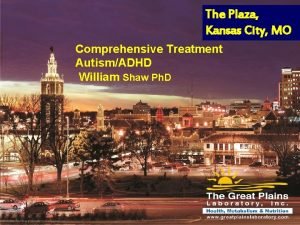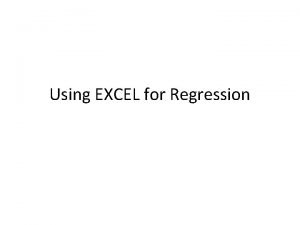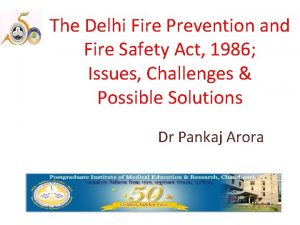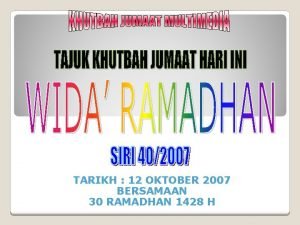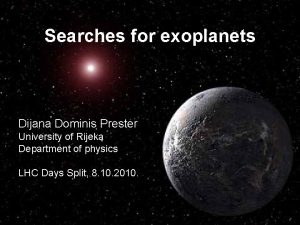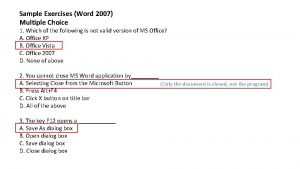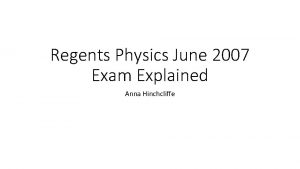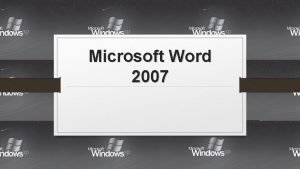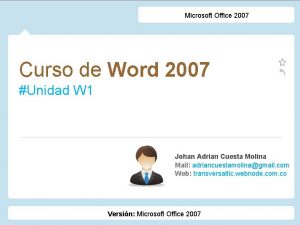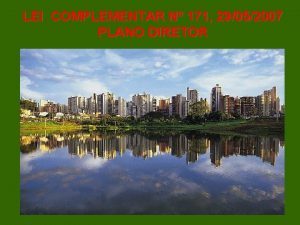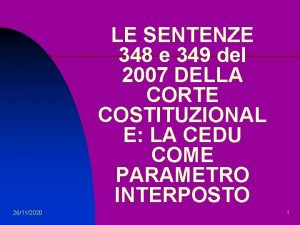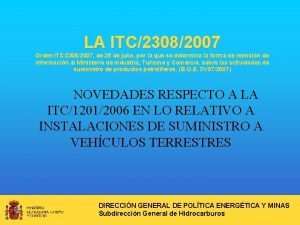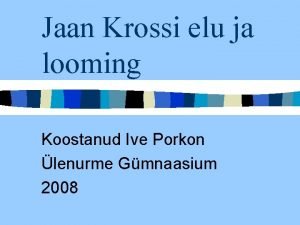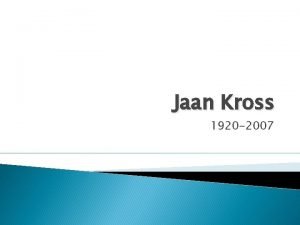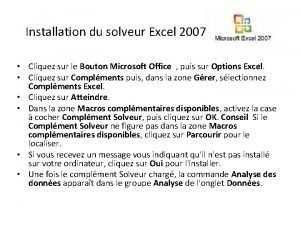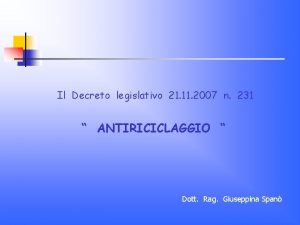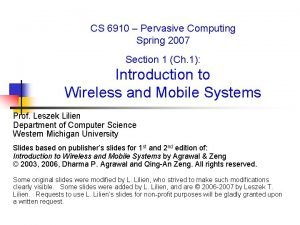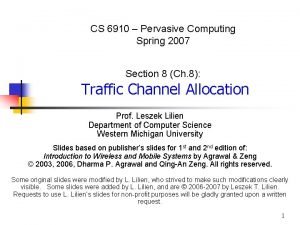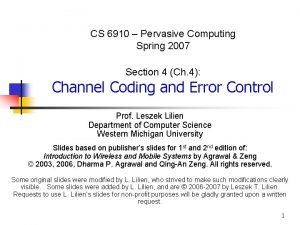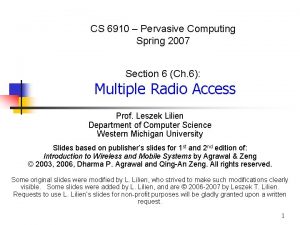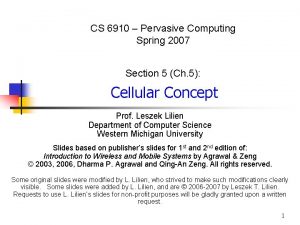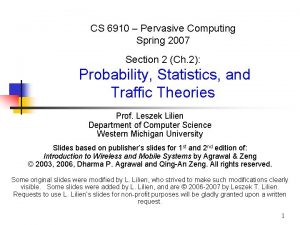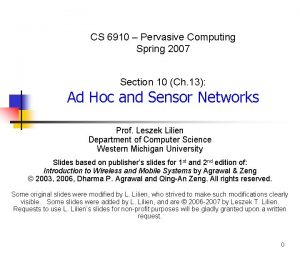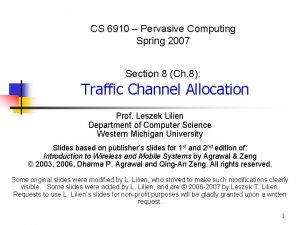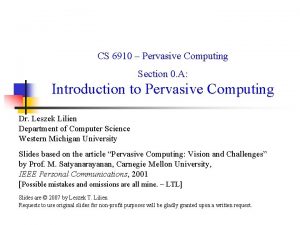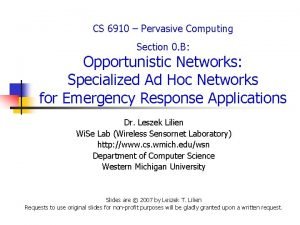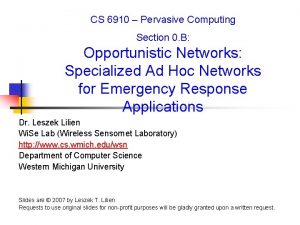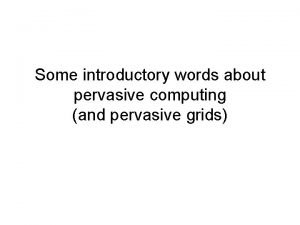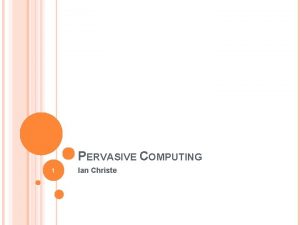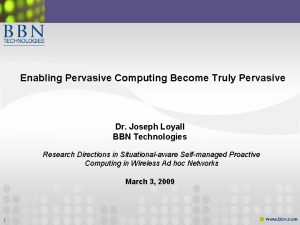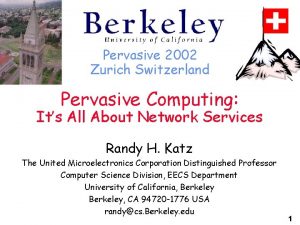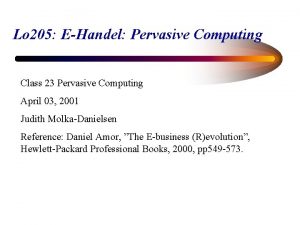CS 6910 Pervasive Computing Spring 2007 Section 3

























![Example of Path Loss (Open Area) [repeated for completeness] Compare loss for, e. g. Example of Path Loss (Open Area) [repeated for completeness] Compare loss for, e. g.](https://slidetodoc.com/presentation_image_h2/dc415b1f617f49ee53732c09856855fe/image-26.jpg)









![*** SKIP *** Moving Speed Effect [LTL: ] This textbook figure is not consistent *** SKIP *** Moving Speed Effect [LTL: ] This textbook figure is not consistent](https://slidetodoc.com/presentation_image_h2/dc415b1f617f49ee53732c09856855fe/image-36.jpg)













![3. 12. Coherence Bandwidth n Gain [cf. http: //en. wikipedia. org/wiki/Gain] = the mean 3. 12. Coherence Bandwidth n Gain [cf. http: //en. wikipedia. org/wiki/Gain] = the mean](https://slidetodoc.com/presentation_image_h2/dc415b1f617f49ee53732c09856855fe/image-50.jpg)





- Slides: 55

CS 6910 – Pervasive Computing Spring 2007 Section 3 (Ch. 3): Mobile Radio Propagation Prof. Leszek Lilien Department of Computer Science Western Michigan University Slides based on publisher’s slides for 1 st and 2 nd edition of: Introduction to Wireless and Mobile Systems by Agrawal & Zeng © 2003, 2006, Dharma P. Agrawal and Qing-An Zeng. All rights reserved. Some original slides were modified by L. Lilien, who strived to make such modifications clearly visible. Some slides were added by L. Lilien, and are © 2006 -2007 by Leszek T. Lilien. Requests to use L. Lilien’s slides for non-profit purposes will be gladly granted upon a written request. 1

Chapter 3 Mobile Radio Propagation Copyright © 2003, Dharma P. Agrawal and Qing-An Zeng. All rights reserved 2

Outline of Chapter 3 We skip a lot of detailed information from this Chapter n n Introduction Types of Waves n n n n Speed, Wavelength, Frequency Radio Frequency Bands Propagation Mechanisms Radio Propagation Effects Free-Space Propagation Land Propagation Path Loss Fading: Slow Fading / Fast Fading Delay Spread Doppler Shift Co-Channel Interference The Near-Far Problem Digital Wireless Communication System Analog and Digital Signals Modulation Techniques Copyright © 2003, Dharma P. Agrawal and Qing-An Zeng. All rights reserved 3

3. 1. Introduction n n This section covers the distinguishing features of mobile radio propagation Model of wireless mobile channel n Time-varying communication path between 2 terminals n Fixed BS and mobile MS n Mobility introduces new challenges into radio propagation Copyright © Leszek 2003, Dharma P. Agrawal and Qing-An Zeng. All rights reserved © 2007 by T. Lilien 4

Speed, Wavelength, Frequency Light speed = Wavelength x Frequency = 3 x 108 m/s = 300, 000 km/s System AC current Frequency 60 Hz Wavelength 5, 000 km FM radio 100 MHz 3 m (88 -99, 100 -108) Cellular (original) 800 MHz 37. 5 cm Ka band satellite 20 GHz 15 mm Ultraviolet light 1015 Hz 10 -7 m Copyright © 2003, Dharma P. Agrawal and Qing-An Zeng. All rights reserved 5

Speed, Wavelength, Frequency – cont. n ** OPTIONAL ** Broadcast Frequencies (cf. http: //en. wikipedia. org/wiki/Radio_frequencies): n AM radio bands: n n n n long waves (now 153– 279 k. Hz, historically up to 413 k. Hz) medium waves (520– 1, 710 k. Hz in the Americas) short waves (2, 300– 26, 100 k. Hz) TV Band I (Channels 2 - 6) = 54 MHz - 88 MHz (VHF) FM Radio Band II = 88 MHz - 108 MHz (VHF) TV Band III (Channels 7 - 13) = 174 MHz - 216 MHz (VHF) TV Bands IV & V (Channels 14 - 69) = 470 MHz - 806 MHz (UHF) Most common cellular bands now in uses worldwide: 850/900/1800/1900 MHz n E. g. , China uses yet another Copyright © Leszek 2003, Dharma P. Agrawal and Qing-An Zeng. All rights reserved © 2007 by T. Lilien 6

3. 2. Types of Radio Waves n n Ground , space, and sky waves Cellular systems use ground & space waves Ionosphere (80 - 720 km) Sky wave Mesosphere (50 - 80 km) Stratosphere (12 - 50 km) Space wave r tte i m s ran Ground wave Recei v er T Earth Copyright © 2003, Dharma P. Agrawal and Qing-An Zeng. All rights reserved Troposphere (0 - 12 km) 7

Radio Frequency Bands Classification Band Initials Frequency Range Extremely low ELF < 300 Hz Infra low ILF 300 Hz - 3 k. Hz Very low VLF 3 k. Hz - 30 k. Hz Low LF 30 k. Hz - 300 k. Hz Medium MF 300 k. Hz - 3 MHz Ground/Sky wave AM med. wave High HF 3 MHz - 30 MHz Sky wave AM short wave Very high VHF 30 MHz - 300 MHz FM, TV Ultra high UHF 300 MHz - 3 GHz TV, cellphones Super high SHF 3 GHz - 30 GHz Extremely high EHF 30 GHz - 300 GHz Tremendously high THF Characteristics Ground wave AM long wave Space wave WLAN 300 GHz - 3000 GHz Copyright © 2003, Dharma P. Agrawal and Qing-An Zeng. All rights reserved 8

3. 3. Propagation Mechanisms n n n Ideal propagation in free space (no obstacles) Radio signals can penetrate simple walls to some extent Large structure, a hill – difficult to pass through Propagation effects due to obstacles n Reflection n Propagation wave impinges on an object which is large as compared to wavelength n n Diffraction n E. g. , the surface of the Earth, buildings, walls, etc. Radio path between transmitter and receiver obstructed by surface with sharp irregular edges Waves bend around the obstacle, even when LOS (line of sight) does not exist Scattering n Objects smaller than the wavelength of the propagation wave n E. g. foliage, street signs, lamp posts Copyright © 2003, Dharma P. Agrawal and Qing-An Zeng. All rights reserved 9

Radio Propagation Effects hb – heights of BS antenna, hm - heights of MS antenna Copyright © 2003, Dharma P. Agrawal and Qing-An Zeng. All rights reserved 10

n n Quality of signal reaching receiver via different types of radio waves n Direct propagation is the best n Reflection is 2 nd best n Diffraction is 3 rd best n Scattering is 4 th best If no direct-path waves (LOS waves) can reach receiver mainly by reflection or diffraction Copyright © 2003, Dharma P. Agrawal and Qing-An Zeng. All rights reserved 11

3. 4. Free-space Propagation hb hm Transmitter n Distance d Receiver The received signal power Pr at distance d: Ae is effective area covered by the transmitter (on the receiver’s side - e. g. , receiver’s antenna) Gt is the transmitting antenna gain (a better antenna has a higher gain) Pt is transmitting power (Assuming that the radiated power is uniformly distributed over the surface of the sphere. ) Copyright © 2003, Dharma P. Agrawal and Qing-An Zeng. All rights reserved 12

** SKIP ** Antenna Gain n For a circular reflector antenna Gain G = ( D / )2 = net efficiency (depends on the electric field distribution over the antenna aperture, losses, ohmic heating , typically 0. 55) D = diameter thus, G = ( D f /c )2, c = f (c is speed of light) Example: n Antenna with diameter = 2 m, frequency = 6 GHz, wavelength = 0. 05 m G = 39. 4 d. B n Frequency = 14 GHz, same diameter, wavelength = 0. 021 m G = 46. 9 d. B * The higher the frequency, the higher the gain for the same-size antenna Copyright © 2003, Dharma P. Agrawal and Qing-An Zeng. All rights reserved 13

Free-space Path Loss n Definition of path loss LP : n n Path loss in free space Pt is transmitted signal power Pr is received signal power (no obstacles): where fc is the carrier frequency The greater the fc , the higher is the loss (see next slide) Copyright © 2003, Dharma P. Agrawal and Qing-An Zeng. All rights reserved 14

Example of Path Loss (Free-space) Copyright © 2003, Dharma P. Agrawal and Qing-An Zeng. All rights reserved 15

3. 5. Land Propagation n The received signal power: where: Gt is the transmitter antenna gain, Gr is the receiver antenna gain, L is the propagation loss in the channel, i. e. , L = LP LS LF Fast fading (long-term f. ) Slow fading (short-term f. ) Path loss Copyright © 2003, Dharma P. Agrawal and Qing-An Zeng. All rights reserved 16

Fast and Slow Fading and Path Loss n Fast fading (short-term fading) – n Microscopic aspect of a channel for mobile comm. n For a moving MS, it represents fading over its every step n Due to scattering of signal by objects near transmitter n n n => Changing wave diffractions Slow fading (long-term fading) – n Variation of propagation loss in a local area (k * 10 m) n Due to obstacles (e. g. , buildings) n For an MS, it represents overall average fading over short distance (e. g. , a couple of blocks) traveled by MS Path loss n Propagation loss over long distances (more below) Copyright © Leszek 2003, Dharma P. Agrawal and Qing-An Zeng. All rights reserved © 2007 by T. Lilien 17

Schematic Diagram of Propagation Loss (and Fading) Fast Fading (Short-term fading) Slow Fading (Long-term fading) Signal Strength Path Loss (d. B) Distance Copyright © 2003, Dharma P. Agrawal and Qing-An Zeng. All rights reserved 18

Copyright © Leszek 2003, Dharma P. Agrawal and Qing-An Zeng. All rights reserved © 2007 by T. Lilien 19

3. 6. Path Loss (for Land Propagation) n Path loss as a fcn of distance Lp = A dα where: A and α: propagation constants d : distance between transmitter and receiver Value of : - 2 -4 - normally - below 2 in some waveguides - 2 in free space, - 3 -4 in typical urban areas - 4 is for relatively lossy environments. - 4 -6 in some environments, such as buildings, stadiums & other indoor environments Copyright © 2003, Dharma P. Agrawal and Qing-An Zeng. All rights reserved 20

n Path loss in decreasing order: n Urban area (large city) n Urban area (medium and small city) n Suburban area n Open area Copyright © 2003, Dharma P. Agrawal and Qing-An Zeng. All rights reserved Path loss Path Loss 21

Path Loss (Urban, Suburban and Open areas) n Notice how LPU is subtracted from in LPS and LPO (Units: MHz, m, etc. , in parentheses) Urban area: hb, hm – see slide 20 where n Suburban area: n Open area: Copyright © 2003, Dharma P. Agrawal and Qing-An Zeng. All rights reserved 22

Example of Path Loss (Urban Area: Large City) Should be on top of this fc list Copyright © 2003, Dharma P. Agrawal and Qing-An Zeng. All rights reserved 23

Example of Path Loss (Urban Area: Medium and Small Cities) Copyright © 2003, Dharma P. Agrawal and Qing-An Zeng. All rights reserved 24

Example of Path Loss (Suburban Area) Compare loss for, e. g. , 30 km & 1500 MHz with Large/Small Urban Copyright © 2003, Dharma P. Agrawal and Qing-An Zeng. All rights reserved 25
![Example of Path Loss Open Area repeated for completeness Compare loss for e g Example of Path Loss (Open Area) [repeated for completeness] Compare loss for, e. g.](https://slidetodoc.com/presentation_image_h2/dc415b1f617f49ee53732c09856855fe/image-26.jpg)
Example of Path Loss (Open Area) [repeated for completeness] Compare loss for, e. g. , 30 km & 1500 MHz with Large/Small Urban & Suburb. Copyright © 2003, Dharma P. Agrawal and Qing-An Zeng. All rights reserved 26

3. 7. Slow Fading n Slow fading (shadowing or log-normal fading) of a signal = longterm spatial and temporal variations in signal strength over “large enough “ distances n n Distance is “large enough “ if it produces gross variation in signal strength for the overall path between the transmitter and receiver Slow fading obeys log-normal distribution (hence one of its names) - The pdf of the received signal level is given in decibels (d. B) by where M is the true received signal level m in d. B (i. e. , 10 log 10 m) M is the area average signal level (i. e. , the mean of M) is the standard deviation in d. B Copyright © 2003, Dharma P. Agrawal and Qing-An Zeng. All rights reserved 27

** SKIP ** Log-normal Distribution 2 p(M) M M The pdf of the received signal level (log-normal distribution) Copyright © 2003, Dharma P. Agrawal and Qing-An Zeng. All rights reserved 28

3. 8. Fast Fading n n Fast fading (short-term fading) of a signal = rapid fluctuations in the spatial and temporal signal characteristics caused by local mulipath n Multipath – since scattered, diffracted, and reflected signals gets to receiver’s antenna over many paths Fast fading occurs over distances of about half a wavelength n n Example: n VHF and UHF (30 MHz - 300 MHz & 300 MHz - 3 GHz) n Vehicle traveling at 30 mph n It passes through several fades in a second Mobile radio signal consists of: n Fast fading signal n Superimposed on a local mean value n Local mean value: constant over a small area / varies slowly as the receiver moves Copyright © Leszek 2003, Dharma P. Agrawal and Qing-An Zeng. All rights reserved © 2007 by T. Lilien 29

Fast Fading - cont. 1 n Modeling fast fading: n When receiver is far from transmitter n No direct radio waves between transmitter & receiver n n Modeled by the Rayleigh distribution n n Reflected waves stronger Useful for modeling when no LOS (below) When receiver is close to transmitter n Direct radio wave between transmitter & receiver is stronger than other waves n n Stronger than reflected, diffracted, or scattered Modeled by the Rician distribution (below) Copyright © Leszek 2003, Dharma P. Agrawal and Qing-An Zeng. All rights reserved © 2007 by T. Lilien 30

Rayleigh Distribution P(r) rm = 1. 777 rm is middle value of envelope signal (i. e. such value that: P(r ≤ rm) = 0. 5) 1. 0 0. 8 =1 0. 6 =2 0. 4 =3 0. 2 0 r 2 4 6 8 10 The pdf of the Rayleigh Distribution r – envelope of the fading signal; - standard deviation Copyright © 2003, Dharma P. Agrawal and Qing-An Zeng. All rights reserved 31

Rician Distribution =0 =1 =2 = 0 means no direct signal => Rayleigh distr. - see the same shape as for Rayleigh distr. with = 1 Pdf p(r) =3 =1 For large (= very strong signal), Rician distr. can be approximated by Gaussian distribution r The pdf of the Rician Distribution r – envelope of the fading signal - amplitude of the direct signal ( = 0 means no direct signal) Copyright © 2003, Dharma P. Agrawal and Qing-An Zeng. All rights reserved 32

Fast Fading - cont. 2 n Modeling fast fading – cont. : n n n When receiver is far from transmitter n Modeled by the Rayleigh distribution When receiver is close to transmitter n Modeled by the Rician distribution Generalized model for any distance – Nakagami distrib. n Rayleigh distribution is its special case n Rician distribution can be closely approximated by it n “Can often be better” than Rician Copyright © Leszek 2003, Dharma P. Agrawal and Qing-An Zeng. All rights reserved © 2007 by T. Lilien 33

Characteristics of Instantaneous Amplitude n n Instantaneous amplitude => potentially fast changing signal Characteristics of instantaneous amplitude n Level crossing rate at a specified threshold (signal level) n Average number of times per second that the signal envelope crosses the threshold in positive-going direction n Fading rate n Number of times that the signal envelope crosses the middle value rm in positive-going direction per unit time n Depth of fading n Ratio of mean square value of fading signal and minimum value of fading signal n n Average depth of fading often used instead Fading duration n Duration for which signal is below a given threshold Copyright © 2003, Dharma P. Agrawal and Qing-An Zeng. All rights reserved 34

3. 9. Doppler Effect (Doppler Shift) n n n Doppler effect - occurs when a wave source and a receiver are moving towards or away from each other n When they are moving toward each other, the frequency of the received signal is higher than the source frequency n When they are moving away from each other, the frequency is lower than the source frequency Received signal frequency is where: f. C - source frequency , f. D - the Doppler shift in frequency Doppler shift is MS Moving direction of the receiver (MS) Signal from source where: v - the moving speed - the wavelength of the carrier of the source signal Copyright © 2003, Dharma P. Agrawal and Qing-An Zeng. All rights reserved 35
![SKIP Moving Speed Effect LTL This textbook figure is not consistent *** SKIP *** Moving Speed Effect [LTL: ] This textbook figure is not consistent](https://slidetodoc.com/presentation_image_h2/dc415b1f617f49ee53732c09856855fe/image-36.jpg)
*** SKIP *** Moving Speed Effect [LTL: ] This textbook figure is not consistent with text referring to it. It is confusing in the context of the Doppler effect (which has to do with signal frequency not signal strength, as the figure suggests). Copyright © 2003, Dharma P. Agrawal and Qing-An Zeng. All rights reserved 36

3. 10. Delay Spread n When a signal propagates from a transmitter to a receiver, it can suffer one or more reflections [Agrawal & Zeng] n n Now, instead of single-path direct signal we have a multipath reflected signal reaching the receiver More descriptively: Each reflection of the original signal produces a new (fainter) “child” signal that follows its own path n n The path followed by the “child” signal is determined by reflection parameters When all “children” signals are put together, we have multiple reflected signals (all originating from the original signal) following a multipath towards the receiver n n Some of the “children” signals may be too faint to reach the receiver Some of the “children” signals may be reflected in wrong direction(s) and never reach the receiver Copyright © Leszek 2003, Dharma P. Agrawal and Qing-An Zeng. All rights reserved © 2007 by T. Lilien 37

Delay Spread – cont n n Different paths in the multipath have different lengths, so the time of arrival for each of many reflected “child” signals is different This spreads out the received signal => is called “delay spread” n n . If we had direct signal only, there would be one signal path, no children signals, and no delay spread See Figure (next) Copyright © 2003, Dharma P. Agrawal and Qing-An Zeng. All rights reserved 38

Delay Spread The signals reflected from nearby reflectors Signal Strength The signals reflected from intermediate reflectors The signals reflected from distant reflectors Delay Q 1: A signal reflected by a nearby reflector arrives sooner than a signal reflected by a more distant reflector. Why? Copyright © 2003, Dharma P. Agrawal and Qing-An Zeng. All rights reserved 39

Delay Spread – cont. 1 n n Q 1: A signal reflected by a nearby reflector arrives sooner than a signal reflected by a more distant reflector. Why? A: First note that the direct path is the shortest path from the xmitter to the receiver. A signal reflected by a nearby reflector already traveled most of the distance d as a direct signal. In other words, such signal already traveled most of the distance d along the shortest path to the receiver. A signal reflected further away from the receiver was reflected earlier, so it traveled more of the distance d as a multipath reflected signal, i. e. , its components (children signals) traveled more of the distance d along a longer (not the shortest) path to the receiver. Copyright © Leszek 2003, Dharma P. Agrawal and Qing-An Zeng. All rights reserved © 2007 by T. Lilien 40

Delay Spread (again) The signals reflected from nearby reflectors Signal Strength The signals reflected from intermediate reflectors The signals reflected from distant reflectors Delay Q 2: A signal reflected by a nearby reflector is stronger than a signal reflected by a more distant reflector. Why? Copyright © 2003, Dharma P. Agrawal and Qing-An Zeng. All rights reserved 41

Delay Spread – cont. 2 n n Q 2: A signal reflected by a nearby reflector is stronger than a signal reflected by a more distant reflector. Why? A: A signal reflected by a nearby reflector already traveled most of the distance d as the strongest (single-path & direct) signal. A signal reflected further away from the receiver was reflected earlier, and traveled more of the distance d as a weaker (multipath & reflected) signal. To be precise, it traveled as a multipath collection of reflected children signals, collectively weaker than the original single-path & direct signal would be. Copyright © Leszek 2003, Dharma P. Agrawal and Qing-An Zeng. All rights reserved © 2007 by T. Lilien 42

Delay Spread – cont. 3 n Typical delay spread: n 3 microsec. in a city area n 10 microsec. in a hilly terrain Copyright © Leszek 2003, Dharma P. Agrawal and Qing-An Zeng. All rights reserved © 2007 by T. Lilien 43

Copyright © Leszek 2003, Dharma P. Agrawal and Qing-An Zeng. All rights reserved © 2007 by T. Lilien 44

3. 11. Intersymbol Interference (ISI) n n Intersymbol Interference (ISI) - caused by delay spread Example of ISI: n 101… digital signal sent from xmitter to rcver n [Agrawal&Zeng] 4 multipaths due to reflections n Single-path direct signal 4 multipath reflected children signals n Each child generated by another reflection of the original signal n See figures in the next 2 slides n Observation – case of ISI: n In Slide +2 multipath components for symbol “ 1” arrive at the time when only multipath components for symbol “ 0” should be arriving => symbol “ 1” interferes with symbol “ 0” Copyright © Leszek 2003, Dharma P. Agrawal and Qing-An Zeng. All rights reserved © 2007 by T. Lilien 45

Intersymbol Interference (ISI) Example Transmission signal 1 1 NULL Time 0 Received signal (Short delay) Time Propagation time n Delayed multipath signals Figure: n Xmitter and receiver are synchronized n n Red broken-line arrows show synchronization “Short delay”: all 4 delayed multipath signals showing NULL 1 arrive within duration of their “time slot “ Copyright © 2003, Dharma P. Agrawal and Qing-An Zeng. All rights reserved Modified by LTL 46

Intersymbol Interference (ISI) Example Transmission signal 1 1 NULL Time 0 Received signal (Long delay) Time Propagation time n Delayed multipath signals Figure n Xmitter and receiver are synchronized n n Red broken-line arrows show synchronization “Long delay”: only 1 delayed multipath signal showing NULL 1 arrives within duration of its “time slot” n 3 delayed multipath signals arrive too late (within the next “time slot”) Copyright © 2003, Dharma P. Agrawal and Qing-An Zeng. All rights reserved Modified by LTL 47

3. 11. Intersymbol Interference (ISI) – cont. 1 n Burst error– a contiguous sequence of symbols, received over a data transmission channel, such that: (a) the first symbol and the last symbol are in error, and (b) there exists no contiguous subsequence of m correctly received symbols within the error burst n The last symbol in a burst and the first symbol in the following burst are separated by m correct bits or more n The length of a burst of errors in a frame is defined as the number of bits from the first error to the last, inclusive n Error burst – occurrence of burst errors n Burst error rate – measures the rate of burst errors n ISI can cause burst errors => ISI has impact on the burst error rate of a channel Copyright © Leszek 2003, Dharma P. Agrawal and Qing-An Zeng. All rights reserved © 2007 by T. Lilien 48

3. 11. Intersymbol Interference (ISI) – cont. 2 n To assure low bit-error rate (BER), digital transmission rate R must be limited by delay spread d as follows: Copyright © 2003, Dharma P. Agrawal and Qing-An Zeng. All rights reserved 49
![3 12 Coherence Bandwidth n Gain cf http en wikipedia orgwikiGain the mean 3. 12. Coherence Bandwidth n Gain [cf. http: //en. wikipedia. org/wiki/Gain] = the mean](https://slidetodoc.com/presentation_image_h2/dc415b1f617f49ee53732c09856855fe/image-50.jpg)
3. 12. Coherence Bandwidth n Gain [cf. http: //en. wikipedia. org/wiki/Gain] = the mean ratio of the signal output of a system to the signal input of the system n n Gain has wide use to characterize amplifiers Linear phase channel (or filter) [cf. http: //en. wikipedia. org/wiki/Linear_phase] = channel with no distortion due to the frequency-selective delays n All frequency components have equal delay times n n In contrast, in a filter/channel with non-linear phase, delay varies with frequency, resulting in phase distortion Flat channel n Passes all frequencies (“spectral components”) with approximately equal gain and linear phase Copyright © Leszek 2003, Dharma P. Agrawal and Qing-An Zeng. All rights reserved © 2007 by T. Lilien 50

3. 12. Coherence Bandwidth – cont. 1 n Coherence bandwidth Bc = channel frequency range over which the channel can be considered “flat” n n In other words: the frequency interval over which two different frequencies f 1 and f 2 of a signal are likely to experience correlated (amplitude) fading [cf. http: //en. wikipedia. org/wiki/Coherence_bandwidth] *** SKIP this bullet *** - NOT EXPLAINED WELL – SEEMS INCONSISTENT WITH THE REST n Bc represents the correlation between 2 fading signal envelopes at frequencies f 1 and f 2 n n Bc is a function of delay spread n n n Correlation => a statistical measure Bigger delay spread => lower correlation Two frequencies that are larger than their coherence bandwidth Bc fade independently Concept of coherence bandwidth useful in diversity reception n Diversity reception = multiple copies of same message are sent using different frequencies Copyright © 2003, Dharma P. Agrawal and Qing-An Zeng. All rights reserved 51

3. 12. Coherence Bandwidth – cont. 2 n n Let S = transmitted signal B = bandwidth of S Bc = channels’ coherence bandwidth If B < Bc => linear transmission of S n Only gain and phase of S are changed => S not distorted n Intuitively, whole B for S is flat (whole B within Bc) If B > Bc => non-linear transmission of S n Part of S truncated => S severely distorted n Intuitively, only part of B for S is flat (part of B outside of Bc) Copyright © Leszek 2003, Dharma P. Agrawal and Qing-An Zeng. All rights reserved © 2007 by T. Lilien 52

3. 13. Cochannel Interference n Cells reuse frequencies n Same freq assigned to different cells => cells using the same frequency interfere with each other n Let: rd - the desired signal ru - the interfering undesired signal - the protection ratio for which rd ru (so that interference of ru is limited by ) n (Probability of) cochannel interference between cells reusing a frequency Pco = P(rd ru ) where P(rd ru ) = probability that rd ru Copyright © 2003, Dharma P. Agrawal and Qing-An Zeng. All rights reserved 53

3. 13. Cochannel Interference n n Cells having the same frequency interfere with each other rd is the desired signal ru is the interfering undesired signal is the protection ratio for which rd ru (so that interference of ru is limited by ) n Cochannel interference between cells using the same frequency Pco = P(rd ru ) n where P(rd ru ) = probability that rd ru Copyright © 2003, Dharma P. Agrawal and Qing-An Zeng. All rights reserved 54

The End of Section 3 Copyright © 2003, Dharma P. Agrawal and Qing-An Zeng. All rights reserved 55
 Pervasive computing wikipedia
Pervasive computing wikipedia Pervasive and mobile computing
Pervasive and mobile computing Pervasive computing ppt
Pervasive computing ppt Techy tipe now
Techy tipe now Mit mobile wireless
Mit mobile wireless Stn 01 6910
Stn 01 6910 Iras 05280-6910
Iras 05280-6910 čsn 01 6910
čsn 01 6910 For chase
For chase Kim ki duk spring summer fall winter
Kim ki duk spring summer fall winter Fall season months
Fall season months X-trace: a pervasive network tracing framework
X-trace: a pervasive network tracing framework Salesforce company overview
Salesforce company overview Primary and secondary stakeholders
Primary and secondary stakeholders Pddst
Pddst Pdd disorder
Pdd disorder Pseudodementia
Pseudodementia Conventional computing and intelligent computing
Conventional computing and intelligent computing Dimensioning section views
Dimensioning section views What is removed section
What is removed section What is a half section
What is a half section What is the definition of chemical potential energy
What is the definition of chemical potential energy Concept mapping chapter 10 meiosis 1 and meiosis 2
Concept mapping chapter 10 meiosis 1 and meiosis 2 Cara mengaktifkan macro di excel 2010
Cara mengaktifkan macro di excel 2010 Regression analysis excel 2007
Regression analysis excel 2007 Mental health act 2007 pdf
Mental health act 2007 pdf Delhi fire service act 2007
Delhi fire service act 2007 Df 23/2007
Df 23/2007 Bulan ramadhan 2007
Bulan ramadhan 2007 Dijana dominis prester
Dijana dominis prester How to create multiple choice questions in word 2007
How to create multiple choice questions in word 2007 Sale of goods and supply of services act 1980
Sale of goods and supply of services act 1980 June 2007 physics regents
June 2007 physics regents Powerpivot excel 2007
Powerpivot excel 2007 Inei censo 2007 resultados
Inei censo 2007 resultados Public procurement act 2007
Public procurement act 2007 Excel 2007 ods
Excel 2007 ods Tombol size button terletak di bagian pojok
Tombol size button terletak di bagian pojok Microsoft office project 2007
Microsoft office project 2007 Office 2007 visio
Office 2007 visio Ms publisher 2007
Ms publisher 2007 Curso de word 2007
Curso de word 2007 Maturita 2006
Maturita 2006 Lineamientos de política de salud en el perú
Lineamientos de política de salud en el perú 29052007
29052007 Sentenze gemelle 348 e 349 del 2007
Sentenze gemelle 348 e 349 del 2007 Mityc envio precios
Mityc envio precios Keputusan menteri pupr no 1044/kpts/m/2018 pdf
Keputusan menteri pupr no 1044/kpts/m/2018 pdf Kirjanik 1920-2007
Kirjanik 1920-2007 Kirjanik jaan 1920-2007
Kirjanik jaan 1920-2007 Ms project 2007 training
Ms project 2007 training Ms word 2010 view tab
Ms word 2010 view tab Installer solveur excel
Installer solveur excel Tabla de contenido vs indice
Tabla de contenido vs indice Putting people first 2007
Putting people first 2007 Dlgs 231 2007
Dlgs 231 2007


